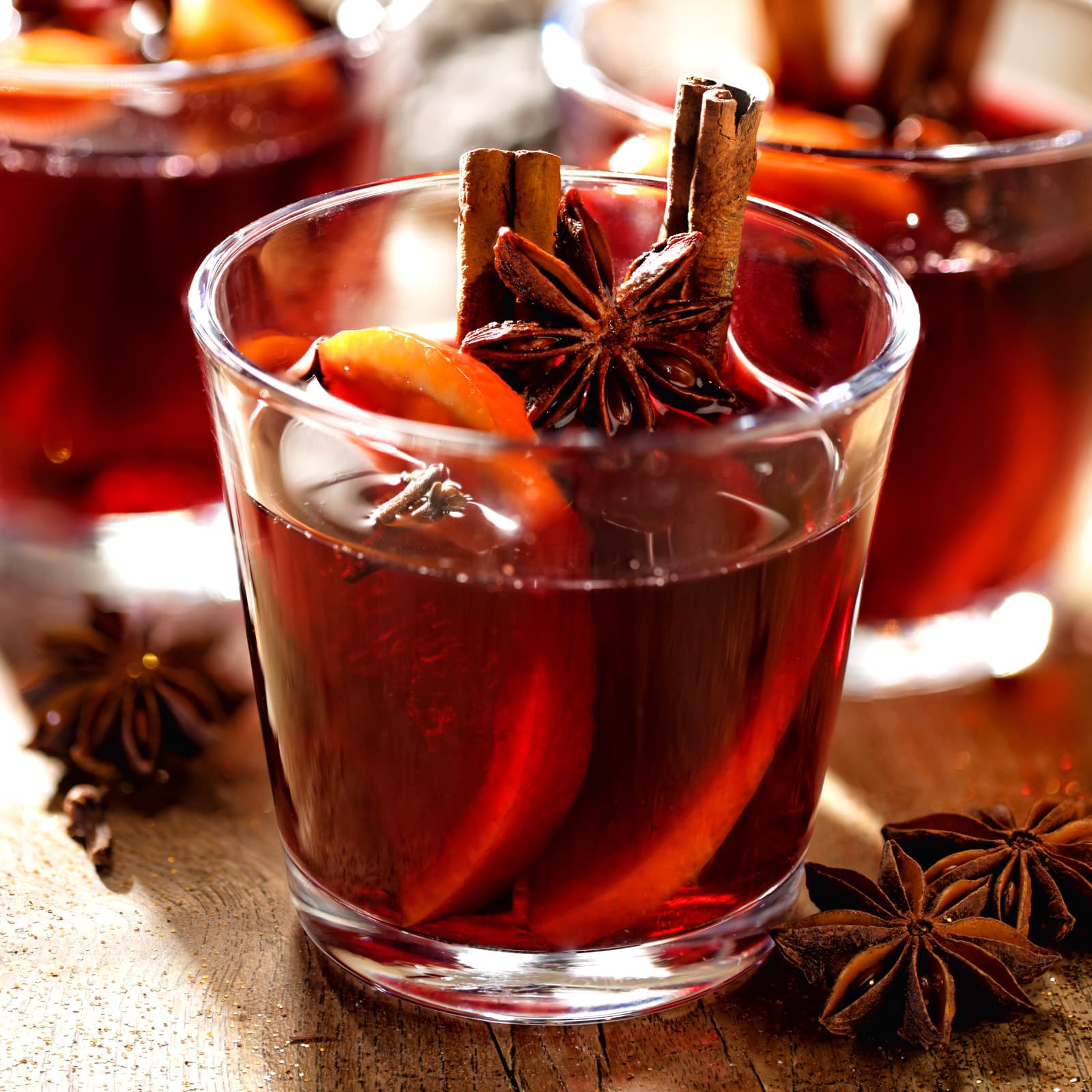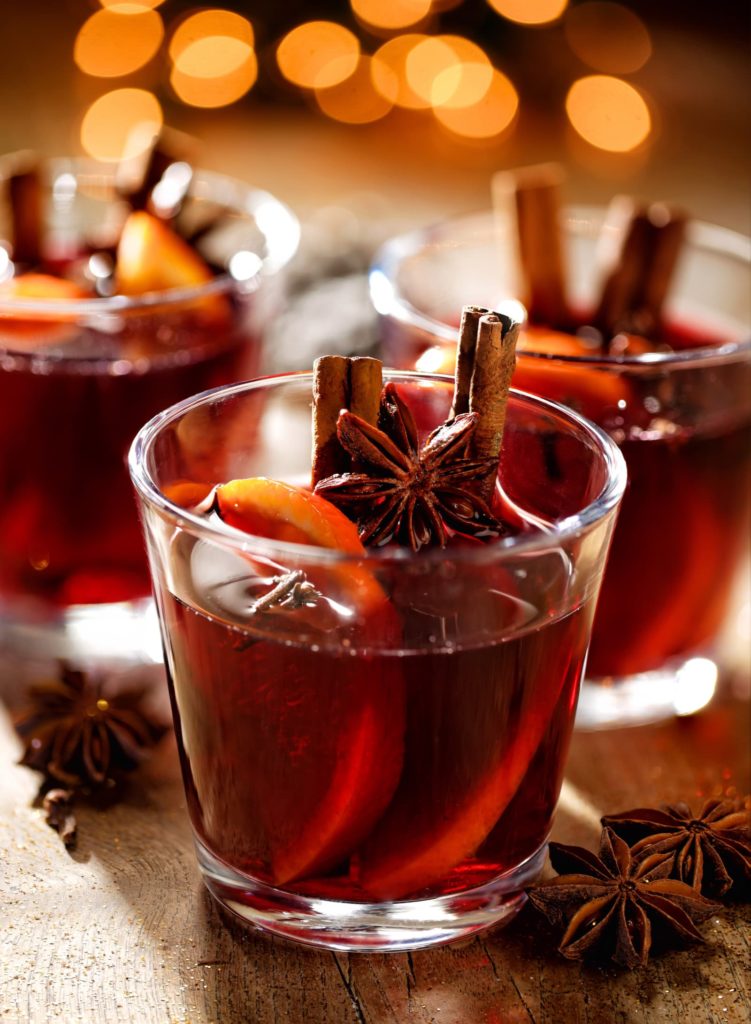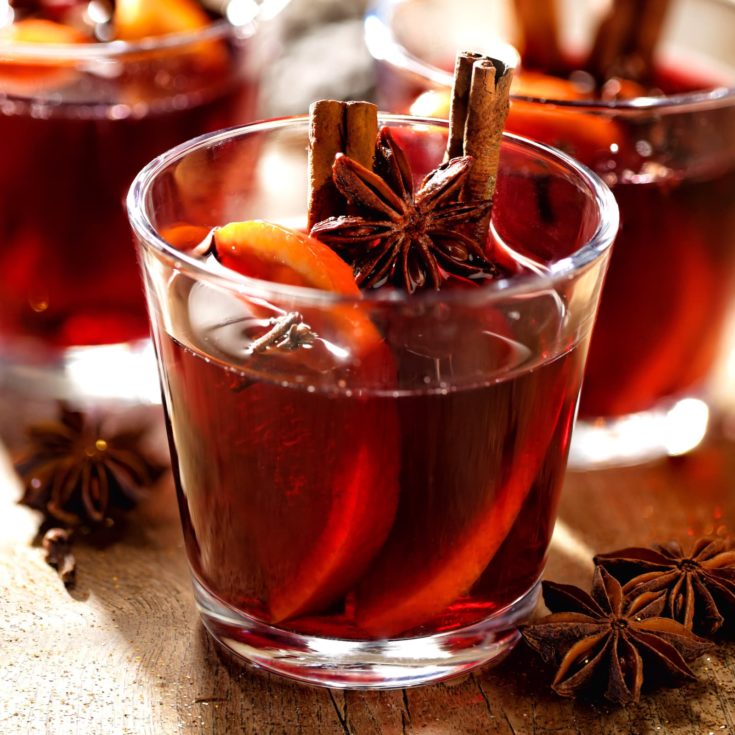Grzane Wino, Grzaniec
Grzaniec: Polish Spiced Mulled Wine
How to pronounce it?
gshaneh vinoh, gshanyetz
‘Play’ to hear:

How to get through a long, harsh winter? Who’s better to advise on this topic than us, Poles :).
And I cannot think of anything better than this fragrant Polish-style Spiced Mulled Wine to kick off the festive season.
Grzaniec or Grzane wino (literally: hot/mulled wine) is made by heating (mostly red) wine and infusing it with a variety of aromatics; such as citrus fruit and spices. It’s served in the winter months at Christmas market stalls, restaurants and bars.
For the full list of ingredients & detailed instructions, please see the recipe card at the end of this post. But before you scroll, there’s important stuff to know below.
Polish-style Grzane Wino is a very close cousin to the German Glühwein, proving their shared origins. Both drinks are derived from Hippocras, an alcoholic beverage tracing back to ancient times and the Middle Ages. (source 1)
What makes our Polish version so special is the honey, used in place of regular sugar or other sweeteners.
Good to know: Grzaniec (pron.: Gshzah-nights) is a Polish term for both ‘Mulled Wine’ AND ‘Mulled Beer‘. Confusing, yes, but you can’t go wrong with any of them.
The idea of heating wine was a popular concept in old-Polish cuisine. Rich, wine-based hot soups (winne polewki) were frequently enjoyed at the courts of Polish royals and aristocrats.
Some of these recipes can be found in Stanisław Czerniecki’s “Compendium Ferculorum” cookbook from the 17th century. (source 2)
Do you need any special ingredients or equipment to make this Polish-style Mulled Wine?
All of the ingredients should be easily available in any well-stocked supermarket. A few things to bear in mind:
- Best wine for Mulled Wine: The wine selection is quite important here – after all, it’s the base of this recipe.
Luckily for our inflation-stricken wallet, it’s not worth investing in an expensive bottle. We’re adding so many spices into it, that you won’t be able to appreciate the original flavours anyway.
Get an affordable red wine, dry or semi-dry, ideally on the heavier, richer side. Sommeliers recommend (source 3) Zinfandel (Primitivo), Shiraz (Syrah), Nero d’Avola or Merlot. - Spices for Mulled Wine: Whole spices are best. Ground spices tend to affect the consistency of the wine, turning it grainy and cloudy. Not cool!
Equipment-wise, you’ll need a wine bottle opener, sharp knife or peeler, citrus juicer, medium pot, strainer and a set of heat-resistant glasses or cups.
How should you serve ‘grzane wino’?
Grzane Wino is usually enjoyed as a late afternoon warm-up drink. When made at home, it tastes best after sledging, skiing or long winter hiking.
The garnishes are completely up to you. Traditionally, it’s served with a few orange slices.
To make your drink even more festive, add a rosemary sprig, cinnamon stick, or a handful of fresh cranberries to float around.
Can you make this spiced Mulled Wine another way?
Sure. Treat this recipe more like a guideline rather than a strict set of rules. You can play with the flavours, for example by adding one (or more) of these:
- vanilla pod
- small piece of fresh ginger root.
- lightly crushed cardamom seeds
- apple juice or soft apple cider
- slices of apple or pear; and even…
- black pepper (sic! It’s a great addition)
If you own a slow cooker or a crock pot, you could use it to make a larger batch of this recipe. Cook on ‘low’ until warm – for 30 minutes up to an hour, depending on the strength of your device.
The ‘Keep warm’ setting will help you keep the right temperature throughout the whole party.
What diets is this ‘grzane wino’ suitable for?
This recipe is suitable for vegetarians. To make it vegan-friendly, replace honey with sugar or vegan maple syrup.
This recipe contains alcohol. For an alcohol-free alternative, replace red wine with cranberry or pomegranate juice (or a mix of both).
How long can you keep this Mulled Wine in the fridge?
Mulled Wine can be refrigerated for up to 3 days. Store it in an airtight container with a lid, ideally made of glass.
I wouldn’t recommend freezing this recipe, the results tend to be underwhelming.
How do I reheat Mulled Wine?
To reheat Grzane Wino, simply pour it into a small pot and warm it up for a few minutes on low heat. As soon as it reaches the desired temperature, take it off the heat and enjoy it immediately.

Grzaniec: Polish Spiced Mulled Wine with Oranges and Cloves

Ingredients
Mulled Wine
- 1 bottle red wine; dry or semi-dry (25.4 oz, 750 ml)
- 2 oranges
- 1 lemon
- 1 cinnamon stick
- 5 cloves
- 3 star anise
- 2 tablespoons honey, can be replaced with maple or raspberry syrup
- 3 tablespoons Sherry, Port or Madeira wine; optional
Garnish (optional)
- ¼ cup (handful) fresh cranberries
- oranges, sliced into half-moons or rounds
- cinnamon sticks
- rosemary sprigs
Instructions
- Pour a whole bottle of red wine into a medium-sized pot.
- Wash the citruses (two oranges and one lemon) thoroughly under running water. Scrub them well with a clean soft brush. Peel them all, carefully avoiding the bitter white part (the pith).
- Add the peel into the pot. Juice the rest of the citruses, add the juice directly into the pot.
- Add the spices: cinnamon stick, cloves and star anise. Add the honey as well.
- Partially cover the pot and gently warm up the mixture over medium heat. Do not bring it to boil - if it’s steaming, it’s hot enough.
- Have a taste. Is it sweet enough? If not, it’s a good moment to add more honey.
- Reduce the heat to a minimum and let the wine simmer for 30 minutes. Don’t be tempted to extend the cooking time, the flavours won’t improve. Quite the contrary: it will turn treacly and overly spiced.
- Pour in 3 tablespoons of fortified wine (Sherry, Port, Madeira), stir them in. We’re adding it at the end to prevent the alcohol from evaporating completely.
- Strain the wine and pour it into heat-resistant glasses or cups.
- Serve warm, with a garnish of your choice (refer back to the ingredients list for some inspiration).
Notes
This recipe was inspired by Grzane Wino (Mulled Wine) recipe from “Palce Lizać” insert to “Gazeta Wyborcza” newspaper, 6 Dec 2010, page 21, ISSN 2082-5714.
I’ve adjusted the list of ingredients and altered the method slightly, to improve the flavour and the overall cooking experience.
Nutrition Information:
Yield:
5Serving Size:
1Amount Per Serving: Calories: 257Total Fat: 1gSaturated Fat: 0gTrans Fat: 0gUnsaturated Fat: 0gCholesterol: 0mgSodium: 151mgCarbohydrates: 37gFiber: 3gSugar: 22gProtein: 1g
Polonist is reader-supported. When you buy through links on our site, we may earn a small affiliate commission. Learn more
Recipe Information
Filed under:
Alternative traditional/regional names:
Grzanka, Grzaniec z Winem, Grzaniec Winny
Also known / Misspelt internationally as:
Tested by:
First published on:
Recipe by / Adapted from:
Story by:
Bibliography / References:
- Read more about Hippocras here: “Hippocras, or spiced wine” by Marissa Nicosia [article in English]
- “Compendium ferculorum or Collection of dishes” by Stanisław Czerniecki (ed. by Jarosław Dumanowski ; in collab. with Magdalena Spychaj) Edition in English, ISBN 9788363580407
- Wine advice comes from “Jakie wino wybrać do grzańca?” by Paulina Jaworska [article in English